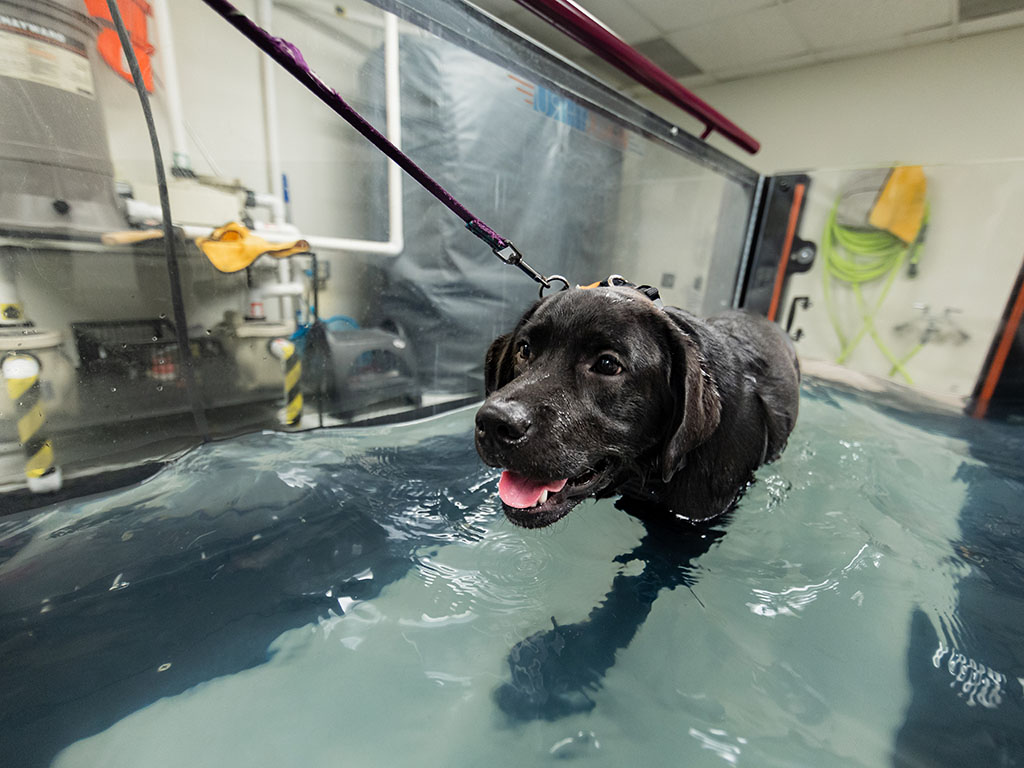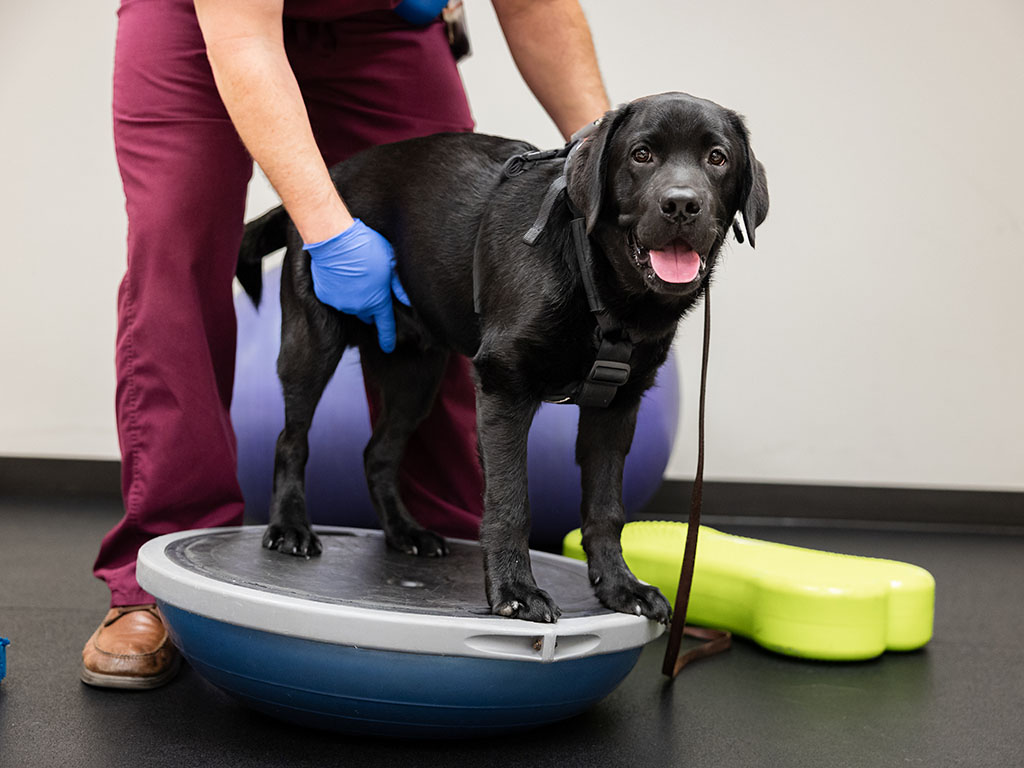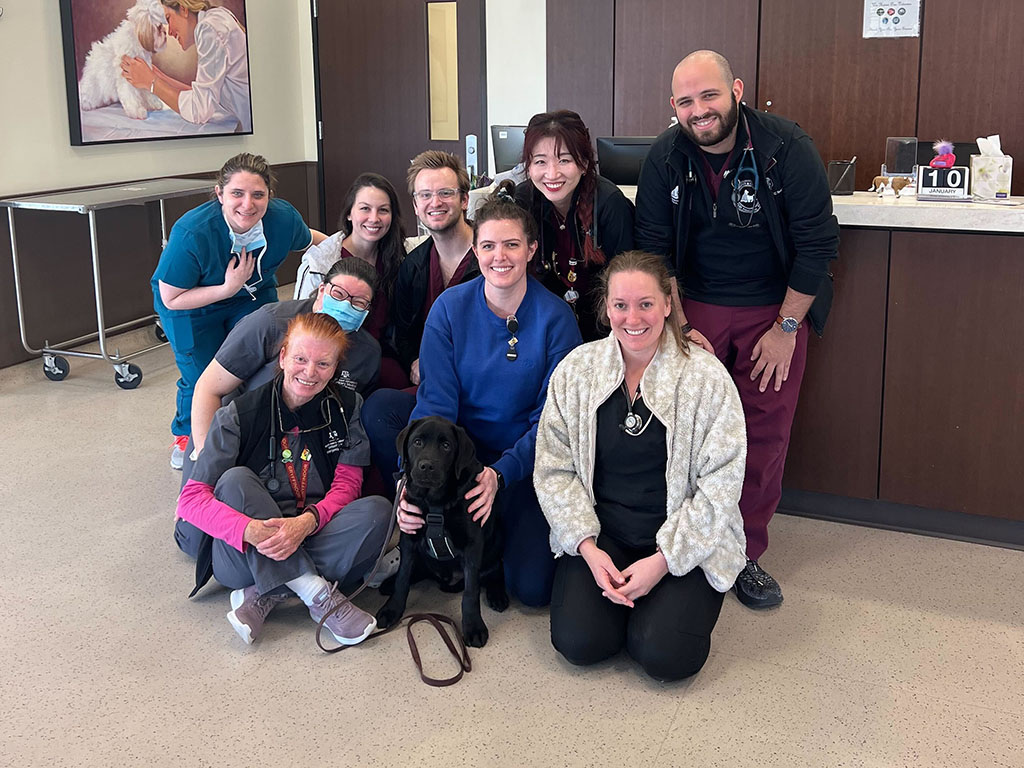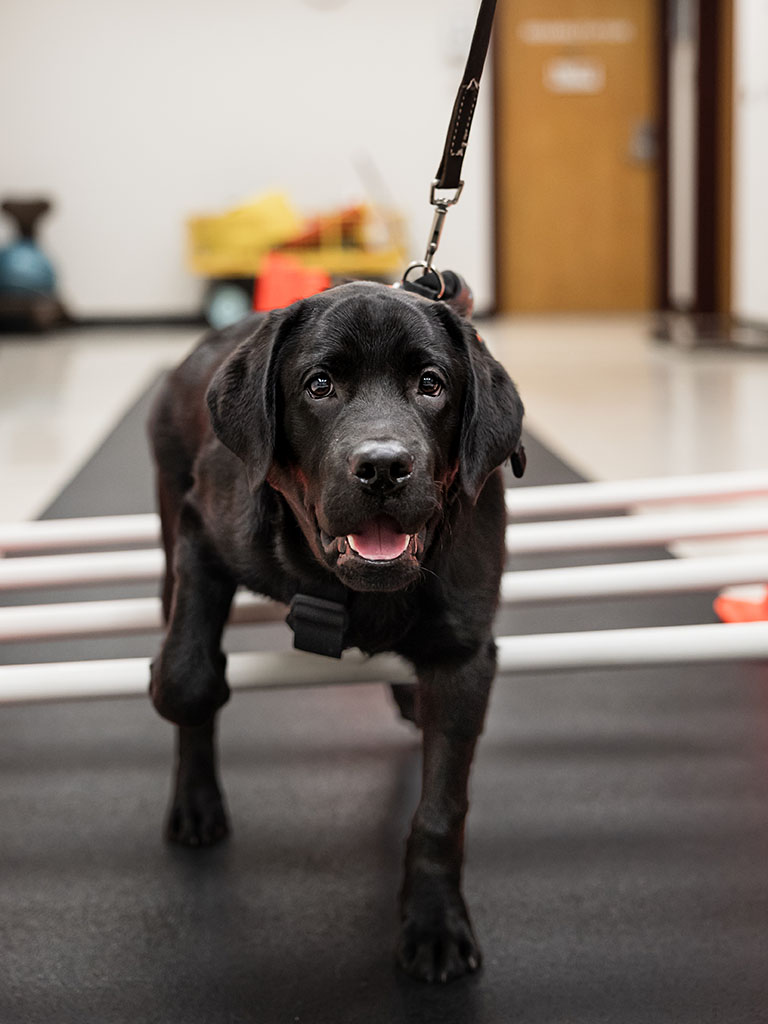Betting On Parlay: Puppy Overcomes Tetanus With Help From Texas A&M Veterinarians
Story by Rachel Knight, VMBS Communications

Photo by Jason Nitsch ‘14, Texas A&M School of Veterinary Medicine & Biomedical Sciences
Parlay, a black Labrador retriever, was named after a gambling term that refers to a series of bets.
When the little lab was diagnosed with tetanus — a serious disease of the nervous system caused by a toxin-producing bacteria — his name took on a new meaning as his veterinary team at the Texas A&M Small Animal Teaching Hospital (SATH) worked to help him beat the odds and survive his condition.
While humans are highly susceptible to the toxin-producing bacteria and are vaccinated regularly for tetanus, there is no tetanus vaccine available for dogs because they are relatively resistant to the disease, according to the National Institutes of Health. However, when dogs contract tetanus, they can experience many of the same symptoms, including lockjaw, stiff muscles that make it impossible for them to bend their legs, muscle spasms in the face, and uncontrollable tightening in the diaphragm, making it difficult to breathe.
After a nearly two-week stay at the SATH with the Emergency & Critical Care Service and months of physical therapy with the Sports Medicine and Rehabilitation Service, Parlay is back in good health.
A Special Connection
Parlay, an energetic puppy with a loving and curious personality, was the pick of the litter when he was born into a show dog family.
“He’s such a great puppy, and he’s always been like that,” said Wendy Knox, Parlay’s owner. “I stayed with him and the rest of his litter 24/7 for the first four weeks of their lives. That’s something I do with every litter. Because of that, I know all the puppies in a litter pretty well, but Parlay is really special.”
Knox was first introduced to the world of show dogs through her parents, who picked up the new hobby once she and her sister had left home for college. She eventually took over showing the dogs for her parents, but in 2012, the family took a break when Knox’s mom was diagnosed with cancer.

Photo by Jason Nitsch ‘14, Texas A&M School of Veterinary Medicine & Biomedical Sciences
“She got pancreatic cancer,” Knox shared. “She lived for almost 19 months and then lost her battle. We miss her terribly bad. The dogs are a connection to my mom now and something I still enjoy doing with my dad and now my husband, too.”
As part of the Knox family, Parlay has a well-rounded routine. Knox and her husband moved into a home on her parents’ 7 acres near Austin, so Parlay has plenty of space to train and gets to see Knox’s father regularly. There, Parlay enjoys long walks, regular swims in a pond, playful training sessions, and lots of love from the family.
“I spend all my waking time, outside of my job as a program director for the Texas Department of Transportation, taking care of my dogs and walking them on our property, swimming with them, and training them,” Knox said. “Parlay really enjoys playing outside and swimming in the pond with his cousin, Kinslee. He’s just the best dog and is very special to me.”
High Stakes Disease
On what started as a normal Saturday in December, Parlay enjoyed playtime outside with Kinslee and then came in for a nap, which was when Knox noticed a small, swollen bump on the left side of Parlay’s face.
“I examined it and thought it might be a bee sting,” Knox shared. “He was acting healthy and normal, so I decided to keep an eye on him for the rest of the day in the house and give him some Benadryl.”
Parlay ended the day seemingly healthy, with no new developments from the bump on his face. The next day, however, Parlay appeared to have some stiffness, so Knox made an appointment with their local veterinarian for Monday morning.
“Sunday evening, we decided he was probably experiencing a scorpion sting instead of a bee sting, but overall, he still seemed pretty healthy,” Knox said. “That was not the case on Monday morning. He was having trouble getting off his doggy bed and when he did, he was much stiffer. Worst of all, it seemed like he was having trouble breathing.”
Knox wasted no time getting Parlay to his veterinarian. When the veterinary team heard he was having trouble breathing, they, too, sprang into action and saw Parlay right away.
“They took Parlay to the back of the clinic, and when they came to see me about 15 minutes later, they said, ‘Your puppy has tetanus,’” Knox shared. “I looked at them blankly and kept asking, ‘What’s tetanus in a dog?’”

Tetanus — also called lockjaw because it causes severe tightness in the jaw and neck, causing the jaw to “lock” — is caused by the bacteria Clostridium tetani, which is found everywhere in the natural environment, including soil, dust, and manure, according to the Centers for Disease Control and Prevention.
The veterinary team explained that the severity of effects from the toxin on the nervous system make the swift administration of antitoxin key to patient survival, while treatment of any conditions or additional ailments that result from the infection are important for assuring quality of life.
Knowing Parlay would need advanced emergency veterinary care around the clock, they informed Knox that she needed to get Parlay to the Texas A&M School of Veterinary Medicine & Biomedical Sciences.
Betting On Parlay
The Bastrop-based veterinary team immediately began calling other clinics to find antitoxin that could be administered to Parlay.
“Since no other emergency veterinarian clinic in the Austin area had the antitoxin, the Bastrop Veterinary Hospital provided me the antitoxin they had on hand for horses” Knox shared. “They packaged me up with two bottles and sent me to Texas A&M. I can still remember them saying, ‘You need to drive and get there as safely as you can but also as quickly as you can. If you don’t, he’s going to die.’”
At the SATH, Parlay and Knox were greeted by Dr. Cody Riffe, a resident clinician on the Emergency & Critical Care Service, who assured Knox they would do everything they could to save Parlay.
“We just didn’t want to give up on him,” Knox said. “As a family, we knew we’d do whatever we could to save him and we knew he was in good hands at Texas A&M.”
As Parlay and his veterinary team continued to combat the bacteria, Parlay’s body experienced severe symptoms, which led to additional ailments, a common challenge with tetanus patients.

Parlay performs a rehabilitation exercise at the SATH
Photo by Jason Nitsch ‘14, Texas A&M School of Veterinary Medicine & Biomedical Sciences
“Parlay had difficulty eating and drinking due to the lockjaw; limb weakness as a result of the severe tightening of the muscles that made it so that he was unable to walk or support his own weight; and aspiration pneumonia, likely a result of the toxin attacking the nerves in his throat and esophagus which allowed saliva or food to enter his airway,” Riffe shared. “Our team worked around the clock to make sure Parlay had the care he needed to combat all his ailments.
“He was here for almost two weeks and during that time, his muscles became locked in an extended position,” Riffe said. “Muscle strength will quickly decline without the constant activity of bearing weight and moving through space, so we referred him to the SATH’s Sports Medicine & Rehabilitation Service to help him strengthen his muscles and live a more comfortable, activity-filled life.”
While Parlay was much improved, he still needed assistance standing and walking when it came time to be discharged from the SATH, so he was sent home with a full body harness that supported his weight.
“We got home at about 1 p.m. on Thursday, and on Friday, he started trying to walk on his own with his weight supported by the special harness,” Knox said. “By Friday night, he was able to walk again, and it was the coolest thing to see him doing so much better.”
Parlaying Veterinary Care Into Health
Now, almost four months after his initial diagnosis, Parlay is easing back into his show dog routine so that he’ll be ready for his first show season.
“He enjoys playing outside again, taking his naps, and getting all the love and attention,” Knox said. “We incorporated some of the exercises we learned in physical therapy into his walks around the property, like having him walk backwards to help rebuild muscles in his legs. As the weather warms again, we’re also going to have him start swimming in our pool for hydrotherapy.”
Knox said she’s incredibly thankful for the care Parlay received at the SATH.
“Every single person I’ve encountered at the Small Animal Teaching Hospital — it doesn’t matter whether they’re in the pharmacy or billing or serving as a technician or clinician — everybody was so nice, professional, and considerate,” Knox said. “I have nothing but good things to say, and that’s why I’d recommend anyone in a similar situation bring their animals to Texas A&M.”
###
For more information about the Texas A&M College of Veterinary Medicine & Biomedical Sciences, please visit our website at vetmed.tamu.edu or join us on Facebook, Instagram, and Twitter.
Contact Information: Jennifer Gauntt, Director of VMBS Communications, Texas A&M College of Veterinary Medicine & Biomedical Sciences, jgauntt@cvm.tamu.edu, 979-862-4216


